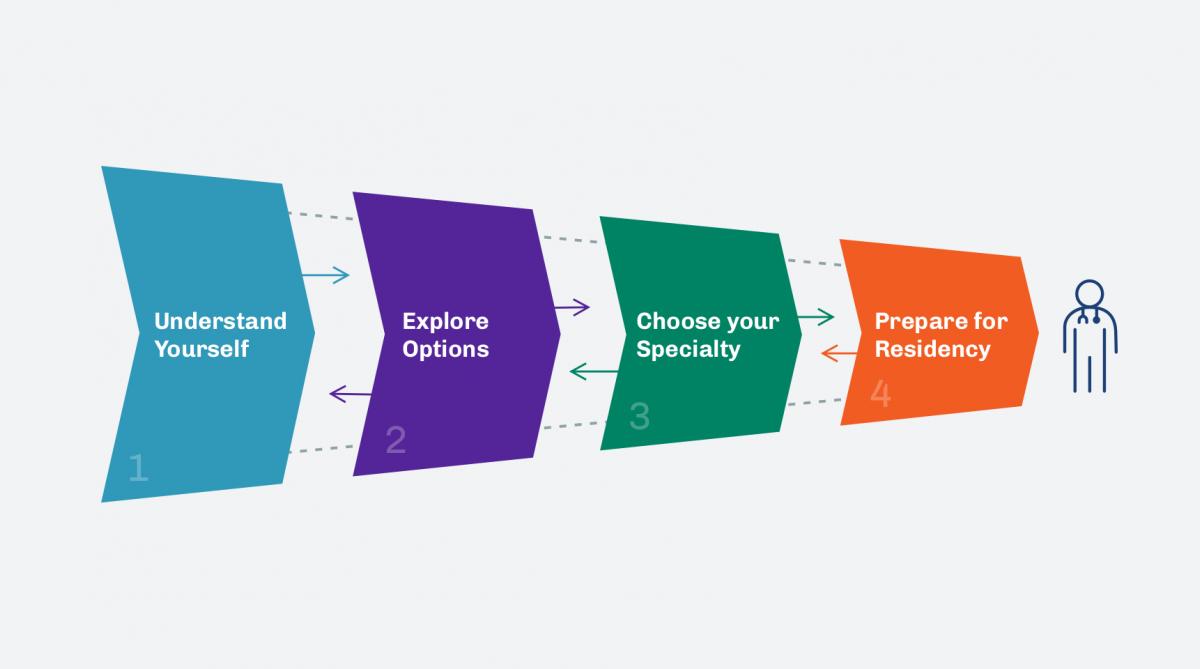While some students begin medical school with a well-conceived idea of the specialty they’ll pursue, just over a quarter of a medical school cohort stick with this choice throughout medical school.1 This means, conversely, about three quarters of a cohort are either undecided about the specialty they'll pursue upon matriculation or end up changing their mind during medical school. In fact, multiple studies have shown that the majority of a cohort will change their mind during medical school.2 3
Regardless of your thoughts about your future specialty and physician career, CiM offers a structured, organized approach to evaluating specialties and making career decisions.
CiM follows a four-step career-planning process grounded in the theory of person-environment fit (previously, Parsons’ trait and factor theory), which shares similar or equivalent concepts with other theories (e.g., person-organization fit, person-job fit) prominently recognized across academic fields (e.g., industrial and organizational psychology, public administration). As such, it is widely recognized across fields that individuals who fit their field, work setting/environment, and other related aspects are more happy and satisfied and, thus, more engaged, productive, or high-performing.
Because the goal is fit, CiM employed the Cognitive Information Processing (CIP) approach (more info here, here, and here), an approach used widely across higher education, and adapted it for the medical field. The CiM four-phase career planning model is to be used as a framework for guiding physicians-in-training through the career exploration process to identify their fit and ultimately land in their next phase of training and, eventually, practice.
In following this model, CiM provides tools and information that help physicians-in-training consider their personal attributes and preferences alongside their career options to make effective decisions about their specialty and residency. Below are a short description of as well as a few highlighted tools and resources for each phase.
Understand Yourself
In this, the first phase, CiM provides self-assessment activities and exercises to help you understand their interests, values, and skills. These tools help you learn more about yourself and your goals for your physician career as well as narrow the list of specialties to those that might be a good fit.
- Learn more about assessing interests and the Medical Specialty Preference Inventory (MSPI)
- Learn more about assessing values and the Physician Values in Practice Scale (PVIPS)
- Learn more about skills and the Physician Skills Inventory (PSI)
Explore Options
This phase helps you explore specialty options and practice settings. CiM offers a starting point for learning about medical specialties by providing information and data on residency program requirements, competitiveness, workforce, compensation, and links to more information for each specialty.
Following this initial career exploration, narrow your specialty options, conduct in-depth research, and gain experience through rotations and electives in the specialties you’re considering.
Choose Your Specialty
The third phase helps you integrate what they’ve learned about yourself and specialties to make a realistic specialty decision that meets your educational and career goals. CiM provides advice and reflections to help you determine your best fit.
Prepare for Residency
This phase helps you transition to residency by providing the information you need to apply to and secure residency training.
CiM provides information addressing scheduling rotations, applying to residency programs, writing your CV and personal statement(s), securing letters of recommendation, interviewing, and other relevant topics. The Residency Preference Exercise (RPE) guides you to identify criteria important to you in your residency training, search for programs, and rate programs based on your personal criteria.
